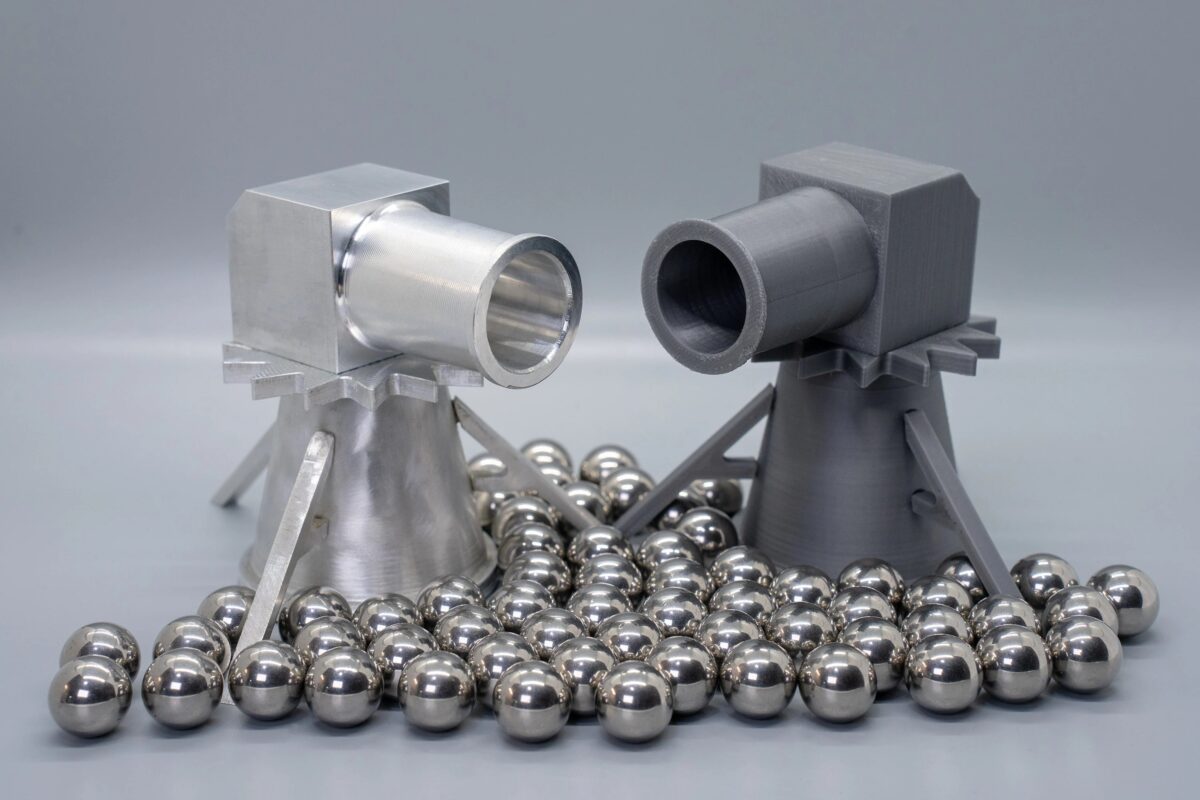Informative
The Differences Between Plastic, Aluminum, and Steel: Machined Versus 3D Printed, and Their Value
In the world of manufacturing, materials and methods play a crucial role in determining the performance, cost, and overall success of a product. Aluminum and steel are two of the most commonly used metals, each with distinct properties and applications. Additionally, the advent of 3D printing technology has revolutionized the manufacturing process, offering new possibilities alongside traditional machining. In this comprehensive blog, we will explore the differences between aluminum and steel, compare machined versus 3D printed components, and evaluate the value of each approach.
Table of Contents
- Introduction to Aluminum and Steel
- Properties of Aluminum
- Types of Aluminum
- Applications of Aluminum
- Properties of Steel
- Types of Steel
- Applications of Steel
- Machined Aluminum and Steel
- Benefits of Machining
- Challenges of Machining
- 3D Printed Aluminum and Steel
- Benefits of 3D Printing
- Challenges of 3D Printing
- Comparative Analysis
- Strength and Durability
- Cost Efficiency
- Design Flexibility
- Value Assessment
- Application-Specific Value
- Future Trends in Manufacturing
- Conclusion
1. Introduction to Aluminum and Steel
Aluminum and steel are essential materials in modern engineering and manufacturing. They are used in a wide range of industries, including aerospace, automotive, construction, and consumer goods. Each metal has unique properties that make it suitable for specific applications, and the choice between them often depends on factors such as weight, strength, corrosion resistance, and cost.
2. Properties of Aluminum
Types of Aluminum
Aluminum is a lightweight, silver-colored metal known for its excellent corrosion resistance and high strength-to-weight ratio. It is available in several alloys, each with specific properties tailored to different applications. The most common types of aluminum include:
- Pure Aluminum (1100 series): Known for its excellent corrosion resistance and formability, but with relatively low strength.
- Aluminum-Copper Alloys (2000 series): These alloys, such as 2024, offer high strength and are commonly used in aerospace applications. They are not as corrosion-resistant as other alloys.
- Aluminum-Manganese Alloys (3000 series): These alloys, like 3003, are known for their good corrosion resistance and moderate strength, often used in beverage cans and cooking utensils.
- Aluminum-Silicon Alloys (4000 series): These alloys are primarily used for welding applications.
- Aluminum-Magnesium Alloys (5000 series): These alloys, such as 5052 and 5083, offer good corrosion resistance and are commonly used in marine environments.
- Aluminum-Magnesium-Silicon Alloys (6000 series): Alloys like 6061 and 6063 are highly versatile, offering good strength, corrosion resistance, and workability. They are widely used in construction and structural applications.
- Aluminum-Zinc Alloys (7000 series): Alloys such as 7075 are among the highest strength aluminum alloys, used in high-performance applications like aerospace and sporting equipment.
Applications of Aluminum
Aluminum’s properties make it suitable for a variety of applications:
- Aerospace: Used in aircraft frames, wings, and other components due to its high strength-to-weight ratio.
- Automotive: Employed in engine blocks, wheels, and body panels to reduce vehicle weight and improve fuel efficiency.
- Construction: Utilized in window frames, roofing, and structural components for its corrosion resistance and durability.
- Consumer Goods: Found in electronics, cookware, and packaging materials.
3. Properties of Steel
Types of Steel
Steel is an alloy of iron and carbon, known for its high strength and versatility. It is available in numerous grades and types, each designed for specific applications. The main types of steel include:
- Carbon Steel: Contains varying amounts of carbon, offering different levels of strength and hardness. Low carbon steel is more ductile, while high carbon steel is harder and more brittle.
- Alloy Steel: Contains additional elements such as chromium, nickel, and molybdenum, which enhance properties like strength, toughness, and corrosion resistance.
- Stainless Steel: Contains at least 10.5% chromium, offering excellent corrosion resistance and used in applications where hygiene and durability are crucial.
- Tool Steel: Known for its hardness and resistance to abrasion, used in making tools and dies.
- Specialty Steels: Designed for specific applications, such as weathering steel (resistant to atmospheric corrosion) and high-speed steel (maintains hardness at high temperatures).
Applications of Steel
Steel’s strength and versatility make it ideal for a wide range of applications:
- Construction: Used in structural beams, reinforcements, and frameworks due to its high strength and durability.
- Automotive: Employed in chassis, body panels, and engine components for its strength and impact resistance.
- Manufacturing: Utilized in machinery, tools, and equipment for its toughness and wear resistance.
- Household Appliances: Found in kitchen appliances, cutlery, and furniture for its corrosion resistance and aesthetic appeal.
4. Machined Aluminum and Steel
Benefits of Machining
Machining is a traditional manufacturing process that involves cutting, shaping, and finishing materials to create precise components. Machining aluminum and steel offers several benefits:
- Precision and Accuracy: Machining allows for tight tolerances and intricate designs, making it suitable for high-precision applications.
- Surface Finish: Provides a smooth surface finish, essential for components that require high aesthetic and functional standards.
- Material Versatility: Can work with a wide range of materials, including various aluminum and steel alloys.
- Scalability: Suitable for both low-volume prototyping and high-volume production runs.
Challenges of Machining
Despite its benefits, machining also presents some challenges:
- Material Waste: Machining produces significant material waste, as excess material is removed to achieve the desired shape.
- Tool Wear: The cutting tools used in machining can wear out quickly, especially when working with hard materials like steel, leading to increased maintenance costs.
- Energy Consumption: Machining requires substantial energy, particularly for high-strength materials, impacting overall production costs.
- Complex Geometries: Creating highly complex geometries can be time-consuming and expensive with traditional machining methods.
5. 3D Printed Aluminum and Steel
Benefits of 3D Printing
3D printing, or additive manufacturing, is a modern technique that builds components layer by layer from digital models. This process offers several advantages:
- Design Flexibility: Allows for the creation of complex geometries that are difficult or impossible to achieve with traditional machining.
- Material Efficiency: Produces minimal material waste, as only the required material is used to build the component.
- Rapid Prototyping: Enables quick production of prototypes, reducing the time from design to testing.
- Customization: Facilitates the creation of customized components tailored to specific requirements without the need for expensive tooling.
Challenges of 3D Printing
However, 3D printing also comes with its own set of challenges:
- Surface Finish: The surface finish of 3D printed parts can be rougher compared to machined parts, often requiring post-processing.
- Material Limitations: Not all materials are suitable for 3D printing, and the mechanical properties of 3D printed parts can vary based on the printing method and material used.
- Size Constraints: The build volume of 3D printers can limit the size of the components that can be produced.
- Cost: While 3D printing can be cost-effective for small batches and complex parts, it may not be as economical as traditional machining for large-scale production.
6. Comparative Analysis
Strength and Durability
- Aluminum: Machined aluminum components are known for their excellent strength-to-weight ratio, making them ideal for applications where weight reduction is crucial. 3D printed aluminum parts can also offer good strength, but the layer-by-layer construction may introduce weaknesses that need to be considered in the design.
- Steel: Steel components, both machined and 3D printed, are renowned for their high strength and durability. Machined steel parts provide consistent properties throughout the component, while 3D printed steel parts can achieve similar strength but may require careful design to avoid weak points.
Cost Efficiency
- Machining: Traditional machining can be cost-effective for high-volume production runs, especially when working with readily available materials and established processes. However, the initial setup costs and material waste can be high for low-volume or highly complex parts.
- 3D Printing: 3D printing offers cost advantages for low-volume production, prototyping, and complex geometries. It eliminates the need for expensive tooling and reduces material waste. However, the cost of 3D printing materials and equipment can be higher than traditional machining for large-scale production.
Design Flexibility
- Machining: While machining offers precision and accuracy, it is limited in terms of design complexity. Intricate internal structures and complex shapes can be challenging and expensive to achieve.
- 3D Printing: 3D printing excels in design flexibility, allowing for the creation of complex and intricate geometries that are difficult or impossible to achieve with traditional machining. This opens up new possibilities for innovative designs and optimized performance.
7. Value Assessment
Application-Specific Value
The choice between aluminum and steel, machined or 3D printed, depends largely on the specific application and its requirements:
- Aerospace: Lightweight and strong, machined aluminum is often preferred for structural components, while 3D printed aluminum allows for complex, weight-optimized parts. Steel is used in areas requiring high strength and durability.
- Automotive: Aluminum components help reduce vehicle weight and improve fuel efficiency. Machined aluminum and steel parts are common for high-precision applications, while 3D printed components offer customization and rapid prototyping.
- Construction: Steel’s strength and durability make it a staple in construction. Machined steel components provide structural integrity, while 3D printed steel can be used for custom architectural elements and complex designs.
- Consumer Goods: Aluminum is popular for its corrosion resistance and aesthetic appeal. 3D printing allows for personalized and intricate designs, enhancing the functionality and attractiveness of consumer products.
Future Trends in Manufacturing
The future of manufacturing is likely to see a blend of traditional machining and 3D printing, leveraging the strengths of both methods:
- Hybrid Manufacturing: Combining machining and 3D printing processes to optimize production, reduce waste, and achieve complex designs with high precision.
- Advanced Materials: Development of new aluminum and steel alloys tailored for both machining and 3D printing, enhancing performance and expanding application possibilities.
- Automation and AI: Integration of automation and artificial intelligence in both machining and 3D printing processes to improve efficiency, accuracy, and scalability.
8. Conclusion
In the evolving landscape of manufacturing, aluminum and steel continue to be indispensable materials, each offering unique properties and advantages. The choice between machined and 3D printed components depends on factors such as design complexity, production volume, cost efficiency, and application-specific requirements.
Machining provides precision and consistency, making it ideal for high-volume production and applications requiring tight tolerances. On the other hand, 3D printing offers unparalleled design flexibility and material efficiency, revolutionizing the production of complex and customized components.
By understanding the differences between these materials and manufacturing methods, industries can make informed decisions to optimize their processes, enhance product performance, and stay competitive in a rapidly changing market.
The future of manufacturing lies in the innovative integration of traditional and modern techniques, harnessing the best of both worlds to create superior products that meet the demands of a diverse and dynamic world.

